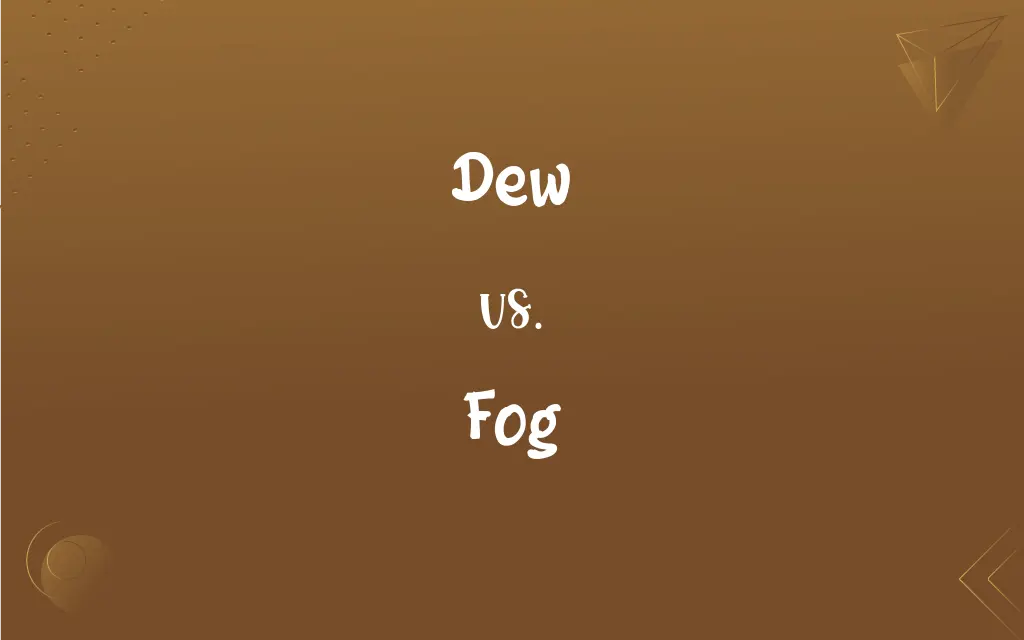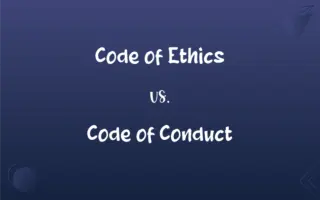Dew vs. Fog: What's the Difference?
Edited by Aimie Carlson || By Janet White || Published on November 22, 2023
Dew is moisture condensed on surfaces, typically overnight, while fog is a cloud-like, ground-level atmospheric condition reducing visibility.

Key Differences
Dew is formed when water vapor condenses into liquid on cool surfaces, often observed in the early morning on grass, leaves, and cars. In contrast, fog is a meteorological phenomenon where tiny water droplets are suspended in the air near the Earth's surface, significantly reducing visibility.
The occurrence of dew is a result of surface objects cooling down at night, leading to water vapor in the air condensing on these cooler surfaces. Fog, however, forms when the air near the ground becomes cool enough to turn its water vapor into liquid droplets, creating a cloud-like appearance close to the ground.
Dew is typically seen in clear, calm weather conditions and signifies the air's dew point has been reached. Fog usually occurs in conditions of high humidity and can be influenced by nearby bodies of water, geographical features, and temperature variations.
While dew is a localized phenomenon forming on individual objects, fog impacts a much larger area, often enveloping landscapes and reducing visibility over roads, bodies of water, and fields.
The presence of dew is often associated with the natural watering of plants and does not impede visibility. On the other hand, fog can present challenges for transportation and outdoor activities due to its density and widespread coverage.
ADVERTISEMENT
Comparison Chart
Formation
Condensation on cool surfaces
Water droplets suspended in air
Weather Conditions
Clear, calm nights
High humidity, temperature variations
Visibility Impact
No impact on visibility
Reduces visibility significantly
Location
Localized on objects
Covers large areas
Effect
Waters plants, harmless
Can disrupt transportation
ADVERTISEMENT
Dew and Fog Definitions
Dew
Moisture appearing on surfaces in the early morning.
Dew covered the lawn like a blanket.
Fog
A cloud of tiny water droplets near the Earth's surface.
The valley was shrouded in thick fog.
Dew
Water vapor condensed into liquid on cool surfaces.
The morning dew glistened on the spiderweb.
Fog
A weather condition often occurring in high humidity.
Fog blanketed the harbor early in the morning.
Dew
A sign of clear and calm weather conditions.
After a night of clear skies, the flowers were wet with dew.
Fog
Reduced visibility due to suspended water droplets.
Driving was difficult in the dense fog.
Dew
A natural phenomenon indicating the air's dew point.
Dew forms when the night air cools down.
Fog
Ground-level cloud formation.
The mountaintop was obscured by rolling fog.
Dew
Liquid droplets resulting from nighttime cooling.
The car's windshield was coated with dew.
Fog
Atmospheric moisture affecting large areas.
The city woke up to a heavy blanket of fog.
Dew
Water droplets condensed from the air, usually at night, onto cool surfaces.
Fog
Condensed water vapor in cloudlike masses lying close to the ground and limiting visibility.
Dew
Something moist, fresh, pure, or renewing
"The timely dew of sleep / ... inclines / Our eye-lids" (John Milton).
Fog
An obscuring haze, as of atmospheric dust or smoke.
Dew
Moisture, as in the form of tears or perspiration, that appears in small drops.
Fog
A mist or film clouding a surface, as of a window, lens, or mirror.
FAQs
How does dew form?
Dew forms when water vapor in the air condenses on cool surfaces at night.
Where is dew commonly seen?
Dew is often seen on grass, leaves, and cars in the morning.
What is dew?
Dew is moisture condensed on cool surfaces, often seen in the morning.
Where does fog typically occur?
Fog occurs in areas with high humidity and can be influenced by water bodies and geographical features.
How does fog form?
Fog forms when air near the ground cools enough to condense water vapor.
Does dew affect visibility?
No, dew does not affect visibility.
Is dew a weather condition?
Dew is more of a natural phenomenon than a weather condition.
Is fog a weather condition?
Yes, fog is considered a meteorological phenomenon.
What is fog?
Fog is a cloud-like condition near the ground, reducing visibility.
Can dew form any time of day?
Dew typically forms at night and is visible in the early morning.
Is dew harmful?
No, dew is generally harmless and can even benefit plants.
Can fog be dangerous?
Fog can be dangerous for transportation due to reduced visibility.
What factors influence fog formation?
Temperature, humidity, and geographical location influence fog formation.
What weather conditions lead to fog?
High humidity and temperature variations can lead to fog formation.
Does fog form in specific locations?
Fog can form over any area but is common near water bodies and in valleys.
Does fog affect visibility?
Yes, fog significantly reduces visibility.
Can fog occur any time of day?
Fog can occur at any time but is most common in the early morning and evening.
What weather conditions lead to dew?
Clear, calm nights are conducive to dew formation.
What is the dew point?
The dew point is the temperature at which air becomes saturated with moisture and dew forms.
Does dew form in specific locations?
Dew forms on any cool surface exposed to moist air.
About Author
Written by
Janet WhiteJanet White has been an esteemed writer and blogger for Difference Wiki. Holding a Master's degree in Science and Medical Journalism from the prestigious Boston University, she has consistently demonstrated her expertise and passion for her field. When she's not immersed in her work, Janet relishes her time exercising, delving into a good book, and cherishing moments with friends and family.
Edited by
Aimie CarlsonAimie Carlson, holding a master's degree in English literature, is a fervent English language enthusiast. She lends her writing talents to Difference Wiki, a prominent website that specializes in comparisons, offering readers insightful analyses that both captivate and inform.































































